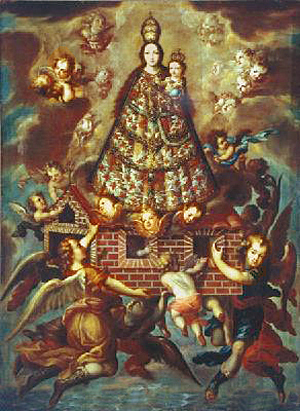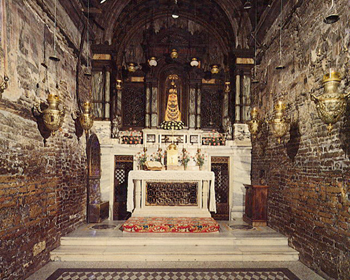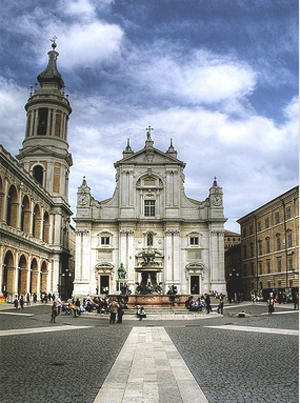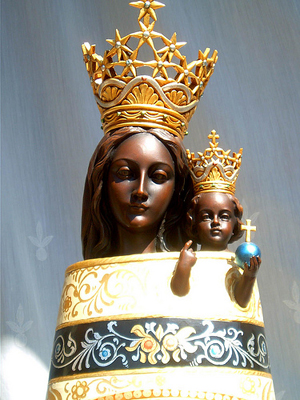 |
The Saint of the Day
Translation of the Holy House to Loreto
December 10
Prof. Plinio Corrêa de Oliveira
Biographical selection:
The holy house where Our Lady lived in Nazareth was translated miraculously to the Italian city of Loreto in the province of Ancona on December 19, 1294 - more than 700 years ago.

Our Lady and the Divine Infant pictured in the translation of the Holy House to Loreto |
The house did not go straight to Loreto, but in the year 1291 it was miraculously transported from Nazareth to the town of Tersatto in Dalmatia (Croatia). The local population, filled with astonishment, did not know how to explain its sudden appearance. Their Bishop, who was gravely ill, now appeared in their midst cured. He had prayed to the Virgin Mary that he might be strong enough to see the prodigy for himself, and the Mother of God appeared to him, surrounded by Angels, saying:
“My son, you have called for me, and here I am. I came to give you succor and to reveal to you the mystery [of the translation of the Holy House] you desire to know. The holy dwelling is the very house where I was born and raised. It was there that I received the good news brought by the Archangel Gabriel and I conceived the Divine Infant by the operation of the Holy Ghost. It was there that the Word was made flesh.
“After my death, the Apostles consecrated this dwelling, illustrious for its great mysteries, and sought the honor of celebrating the August Sacrifice there. The altar is the very one that the Apostle Peter erected; the crucifix was placed there by the Apostles. The small cedar statue is an image of me made by the Evangelist Luke, who, moved by his attachment and affection for me, expressed through his art my features as perfectly as possible for a mortal.
“This beloved house, so dear to Heaven, highly honored for many centuries in Galilee but today deprived of due homage caused by the general decay of the Faith, has been transported from Nazareth to these lands. The author of this great event is God, for whom nothing is impossible.
“For you to bear witness to all that I am telling you now, you will suddenly be cured and return to full health after the long illness you have borne, so that through you all will believe in this miracle.”

The interior of the Holy House of Nazareth |
After the Moslem takeover of Albania in 1294 and the possibility of profaning the Holy House of Nazareth, it disappeared from Tersatto. According to reports of shepherds, that house miraculously appeared in a wooded area four miles from Recanati, Italy, on December 10, 1294. The news spread fast, and soon it was visited by many pilgrims.
From there, for reasons only known to Divine Providence, the house moved twice in the same region and finally came to rest where the town of Loreto is today.
The people of Loreto sent a group of 16 men to Tersatto and Nazareth to determine for certain the origin of the Holy House. They related that the foundations of the house were still in Nazareth and that they matched the house in Loreto, which has stood in a marvelous way for hundreds of years with no foundation.
Over the centuries, many Pontiffs have testified to the authenticity of the Holy House and the miracles that have been attributed to it and have granted numerous indulgences to those who visit it.
Comments of Prof. Plinio:
We are in the presence of a true marvel, of one miracle that testifies to another miracle. Men could have seen the Holy House of Nazareth being carried through the air by Angels and have heard their heavenly canticles. They could have witnessed one of the most beautiful scenes in History and thus have believed in that fact. But God does not always work such evident miracles. Generally, God works miracles that give certainty that something extraordinary took place, but He does not provide irrefutable evidence. The difference between certainty and evidence is that a man of bad faith cannot refuse to believe the latter. When there is certainty, the man of good faith believes but the man of bad faith does not.

The Basilica of Loreto was built in the 15th century to encase the Holy House |
For instance, let us say that at the Lourdes Grotto, a man who was blind is cured by Our Lady. We have the certainty that the man was blind and that he was actually cured. But what if a man who had no eyeballs were to suddenly appear with two new eyes filling the empty spaces of his face? Then the miracle would be of a kind that no one – even a man of bad faith – could deny. Divine Providence rarely works this last kind of miracle.
To witness the Holy House of Nazareth soaring in the air and landing in a city of the Adriatic would be a miracle of the sort that provides irrefutable evidence. Divine Providence did not do that. Instead, God worked a miracle in a way that men – relying on some reasonable proofs – could believe that it was a miracle.
A first proof was the fact of its marvelous appearance. After the material of the house was examined, it showed that the house had been built in Asia Minor. Nonetheless, it had appeared suddenly in a small village where no one had ever seen it before. You know that in a small village everyone knows every house. It is not possible for a new house to appear overnight without anyone seeing it being built. This fact in itself already has a miraculous note.
A second proof was that the Bishop, who was very ill, was cured and reported that he had a vision explaining the miracle.
A third proof was that after the appearance of the house, persons traveled to Nazareth to check if the Holy House were still there or if it had disappeared. In fact, it had vanished.
Thus, the miracle appears as certain.

A statue of Our Lady of Loreto |
It is also worthwhile to note how Divine Providence arranged for so many marvels to occur in one single house. Our Lady was born there; she was raised in it until she went to the Temple at age three. She returned there after her marriage to St. Joseph. She was living there when the Annunciation took place and the Word became flesh. Apparently St. Joseph returned to that same house after the long sojourn in Egypt, and it was there that he and Our Lady lived with Our Lord until He began His public life.
This house has such a long chain of sacred events occurring in it that it is hard to believe anything more could be added. With each new sacred event that took place there, the House acquired a new title for veneration.
Why did Divine Providence allow so many holy events to happen in the same place? It is because God, who is the Author of everything good that exists, knows the mysterious relationship between the natural and religious spheres. He wished those events to happen in accordance with mysterious affinities corresponding to the designs of His Wisdom. One day in Heaven we will know those affinities. He did not want such a precious relic to remain among tepid Catholics and at risk of being profaned by the Muslims.
St. Louis Grignion de Monfort stresses that the Word Incarnate desired to remain obedient to Our Lady during His gestation in her womb and before His public life when he lived with her and St. Joseph. We should consider that a considerable part of His private life passed in the Holy House of Nazareth.
So, on this day when the Church celebrates the translation of the Holy House from Nazareth to Loreto, let us turn our minds to that sacred place and ask Our Lady to give us a greater understanding of, and admiration for, the private life of Our Lord as he lived in that House, obedient to St. Joseph and the Blessed Virgin. Then, let us pray that, in imitation of Our Lord, we might have a more profound and intense dependence on Our Lady.


  | | Prof. Plinio Corrêa de Oliveira | |
The Saint of the Day features highlights from the lives of saints based on comments made by the late Prof. Plinio Corrêa de Oliveira. Following the example of St. John Bosco who used to make similar talks for the boys of his College, each evening it was Prof. Plinio’s custom to make a short commentary on the lives of the next day’s saint in a meeting for youth in order to encourage them in the practice of virtue and love for the Catholic Church. TIA thought that its readers could profit from these valuable commentaries.
The texts of both the biographical data and the comments come from personal notes taken by Atila S. Guimarães from 1964 to 1995. Given the fact that the source is a personal notebook, it is possible that at times the biographic notes transcribed here will not rigorously follow the original text read by Prof. Plinio. The commentaries have also been adapted and translated for TIA’s site.
|
Saint of the Day | Home | Books | CDs | Search | Contact Us | Donate

© 2002- Tradition in Action, Inc. All Rights Reserved
|
 |

|